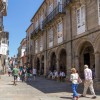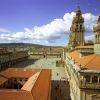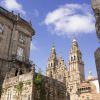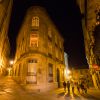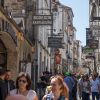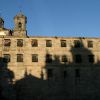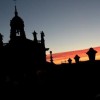- Accede I
- Regístrate I
- carrito
Por las rúas
A la Casa del Deán siguen en la rúa do Vilar otros caserones renacentistas, barrocos y neoclásicos que dan fe del carácter privilegiado de la calle dentro del trazado medieval. Estas residencias nobiliarias, que responden al prototipo de pazo urbano, se caracterizan por sus grandes escudos y la calidad de sus trabajos de cantería y forja ornamental. Avanzando hacia la Plaza de O Toural, aparecen ejemplos como la Fundación TorrenteBallester (nº 7) y la Fundación Caixa Galicia (nº 19), que cuentan con interesantes exposiciones; el Pazo de Monroy (nº 18), de limpio estilo renacentista, y el Pazo de Vaamonde (nº 59), sede del Consorcio de Santiago, vecino del callejón de Entrerrúas, el más estrecho de la ciudad. Interesante resulta también el eclecticismo del antiguo Casinode los Caballeros (nº 35), un club de elites fundado en 1876 cuya cafetería decorada con interesantes relieves de madera y medallones de figuras mitológicas y literarias- está hoy abierta al público.
Tras pasar por la sede de Turismo de Santiago, la Oficina Municipal de Información Turística, se llega a la Plaza de O Toural. Este antiguo punto de venta de ganado y aprovisionamiento de agua muestra, alrededor de la fuente de 1822, algunos de los elementos consustanciales a la arquitectura urbana: pavimento de granito, pasos asoportalados para guarecerse de la lluvia, galerías para controlar la temperatura y la luz de las estancias interiores; escudos y nobles balcones. El más destacable es el Pazo de Bendaña, del siglo XVIII, obra de Clemente Fernández Sarela. Remata su fachada la figura del Atlas que sostiene la bóveda celeste. En la actualidad alberga a la Fundación Granell y el museo del mismo nombre, que recogen el legado del artista surrealista gallego Eugenio Granell.
Rúa Nova
Para conocer más ejemplos de pazos puede recorrerse la rúa Nova, que lleva el mismo nombre -“nueva” en castellano- desde hace 800 años. En ella destacan laCasa das Pomas , barroca, y el Pazo de Santa Cruz, del siglo XIX, muy cercanos a dos de los bastiones culturales compostelanos, el Teatro Principal -fundado en 1841- y el Salón Teatro .
Entre las residencias aparece la iglesia de Santa María Salomé, la única de España dedicada a la madre de los apóstoles Santiago y Juan Evangelista. Posee un curioso atrio cubierto, que sobrevivió a los derribos de los soportales que protegen el paseo. El templo barroco conserva una portada románica, con una virgen sedente del siglo XIV. A ambos lados aparecen las dos figuras de una Anunciación del siglo XV, con la particularidad de que la Virgen muestra ya un visible embarazo. En el interior de la iglesia es todo un reto encontrar al angelillo con gafas que decora el apoyo de un retablo.
La rúa de Tras Salomé conduce al Pazo de Fonseca, una casona renacentista encargada a mediados del siglo XVI por la ilustre familia que dio a la ciudad tres arzobispos, uno de ellos fundador de la Universidad. De la traza original del arquitecto Gil de Hontañón se conserva el bajo, decorado por medallones. Cerca se halla elColexio das Orfas (Huérfanas, en castellano), o Convento de los Remedios, fundado en el siglo XVII –época a la que corresponden la iglesia y el campanario- y reformado exteriormente en el siglo XVIII .









